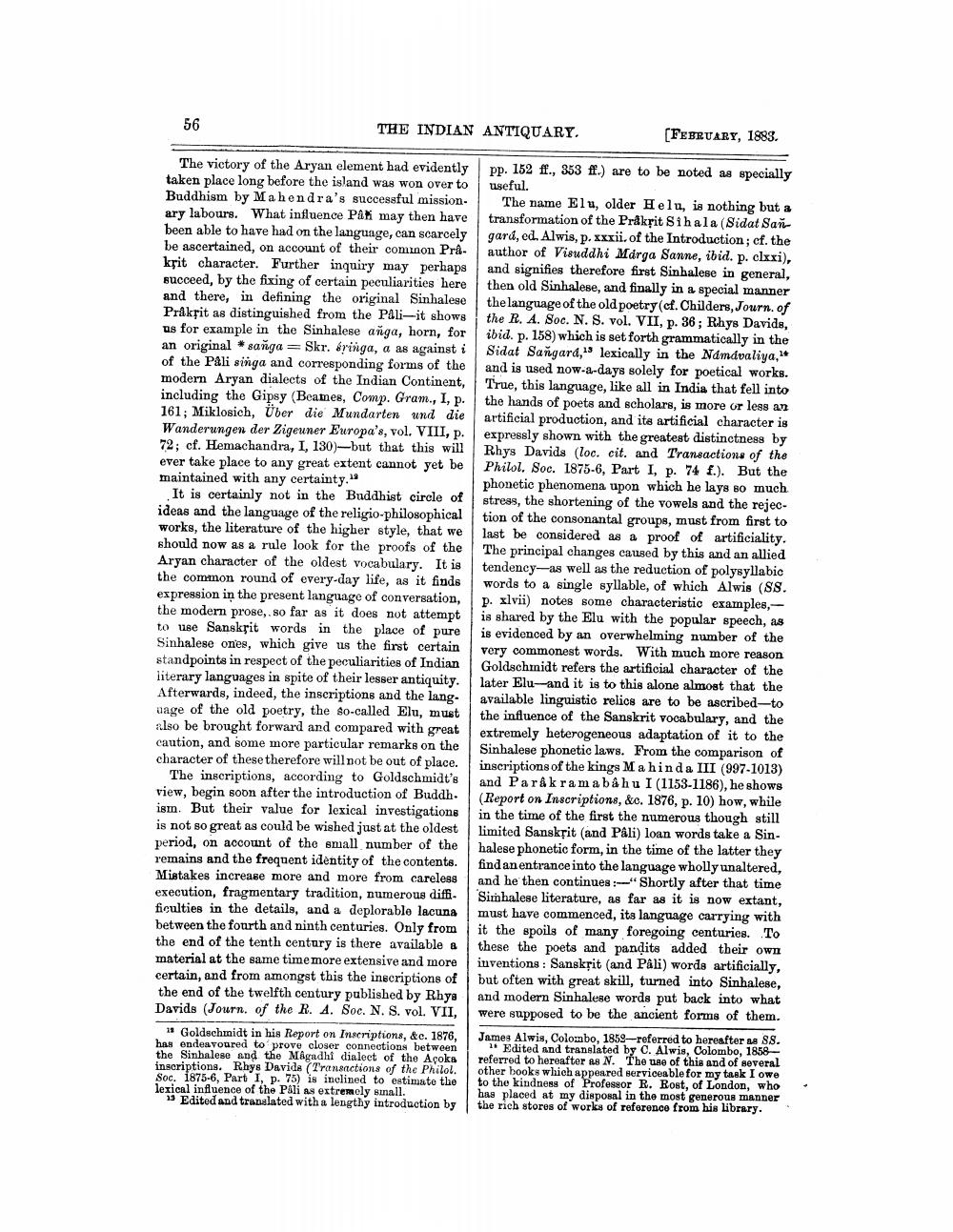________________
56
THE INDIAN ANTIQUARY.
The victory of the Aryan element had evidently taken place long before the island was won over to Buddhism by Mahendra's successful missionary labours. What influence Pâ may then have been able to have had on the language, can scarcely be ascertained, on account of their cominon Prakrit character. Further inquiry may perhaps succeed, by the fixing of certain peculiarities here and there, in defining the original Sinhalese Prakrit as distinguished from the Pali-it shows us for example in the Sinhalese anga, horn, for an original sanga: Skr. éringa, a as against i of the Pâli singa and corresponding forms of the modern Aryan dialects of the Indian Continent, including the Gipsy (Beames, Comp. Gram., I, p. 161; Miklosich, Über die Mundarten und die Wanderungen der Zigeuner Europa's, vol. VIII, p. 72; cf. Hemachandra, I, 130)-but that this will ever take place to any great extent cannot yet be maintained with any certainty.
It is certainly not in the Buddhist circle of ideas and the language of the religio-philosophical works, the literature of the higher style, that we should now as a rule look for the proofs of the Aryan character of the oldest vocabulary. It is the common round of every-day life, as it finds expression in the present language of conversation, the modern prose,. so far as it does not attempt to use Sanskrit words in the place of pure Sinhalese ones, which give us the first certain standpoints in respect of the peculiarities of Indian literary languages in spite of their lesser antiquity. Afterwards, indeed, the inscriptions and the language of the old poetry, the so-called Elu, must also be brought forward and compared with great caution, and some more particular remarks on the character of these therefore will not be out of place.
The inscriptions, according to Goldschmidt's view, begin soon after the introduction of Buddh. ism. But their value for lexical investigations is not so great as could be wished just at the oldest period, on account of the small number of the remains and the frequent identity of the contents. Mistakes increase more and more from careless execution, fragmentary tradition, numerous diffi. ficulties in the details, and a deplorable lacuna between the fourth and ninth centuries. Only from the end of the tenth century is there available a material at the same time more extensive and more certain, and from amongst this the inscriptions of the end of the twelfth century published by Rhys Davids (Journ. of the R. A. Soc. N. S. vol. VII,
12 Goldschmidt in his Report on Inscriptions, &c. 1876, has endeavoured to prove closer connections between the Sinhalese and the Mâgadhi dialect of the Açoka inscriptions. Rhys Davids (Transactions of the Philol. Soc. 1875-6, Part I, p. 75) is inclined to estimate the lexical influence of the Pali as extremely small.
13 Edited and translated with a lengthy introduction by
[FEBRUARY, 1883.
pp. 152 ff., 353 ff.) are to be noted as specially
useful.
The name Elu, older Helu, is nothing but a transformation of the Prakrit Sihala (Sidat Sangard, ed. Alwis, p. xxxii. of the Introduction; cf. the author of Visuddhi Márga Sanne, ibid. p. clxxi), and signifies therefore first Sinhalese in general, then old Sinhalese, and finally in a special manner the language of the old poetry (cf. Childers, Journ. of the R. A. Soc. N. S. vol. VII, p. 36; Rhys Davids, ibid. p. 158) which is set forth grammatically in the Sidat Sangard, lexically in the Námávaliya, and is used now-a-days solely for poetical works. True, this language, like all in India that fell into the hands of poets and scholars, is more or less an artificial production, and its artificial character is expressly shown with the greatest distinctness by Rhys Davids (loc. cit. and Transactions of the Philol. Soc. 1875-6, Part I, p. 74 f.). But the phonetic phenomena upon which he lays so much stress, the shortening of the vowels and the rejection of the consonantal groups, must from first to last be considered as a proof of artificiality. The principal changes caused by this and an allied tendency as well as the reduction of polysyllabic words to a single syllable, of which Alwis (SS. p. xlvii) notes some characteristic examples,is shared by the Elu with the popular speech, as is evidenced by an overwhelming number of the very commonest words. With much more reason Goldschmidt refers the artificial character of the later Elu-and it is to this alone almost that the available linguistic relics are to be ascribed-to the influence of the Sanskrit vocabulary, and the extremely heterogeneous adaptation of it to the Sinhalese phonetic laws. From the comparison of inscriptions of the kings Mahinda III (997-1013) and Parakramabahu I (1153-1186), he shows in the time of the first the numerous though still (Report on Inscriptions, &c. 1876, p. 10) how, while limited Sanskrit (and Pâli) loan words take a Sinhalese phonetic form, in the time of the latter they find an entrance into the language wholly unaltered, and he then continues:" Shortly after that time Simhalese literature, as far as it is now extant, must have commenced, its language carrying with it the spoils of many foregoing centuries. To these the poets and pandits added their own inventions: Sanskrit (and Pâli) words artificially, but often with great skill, turned into Sinhalese, and modern Sinhalese words put back into what were supposed to be the ancient forms of them.
James Alwis, Colombo, 1859-referred to hereafter as SS. 1 Edited and translated by C. Alwis, Colombo, 1858referred to hereafter as N. The use of this and of several other books which appeared serviceable for my task I owe to the kindness of Professor R. Rost, of London, who has placed at my disposal in the most generous manner the rich stores of works of reference from his library.




